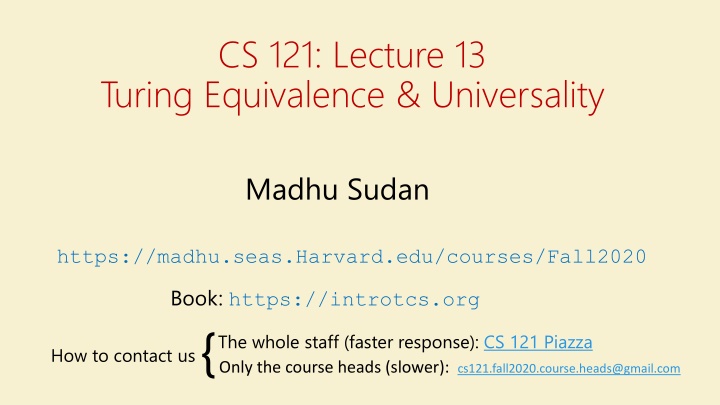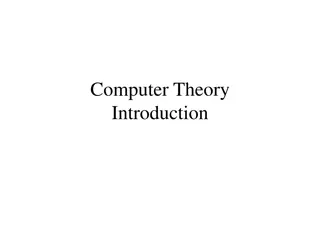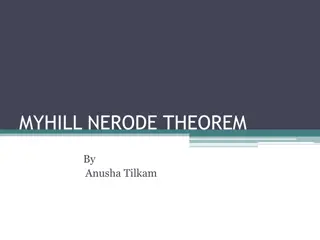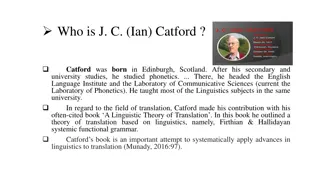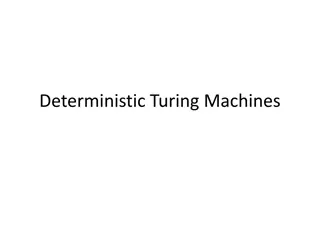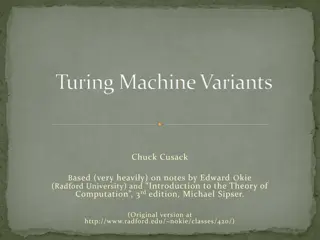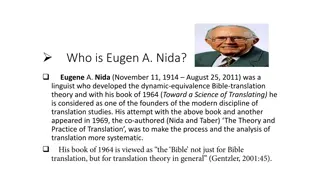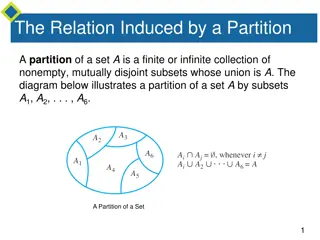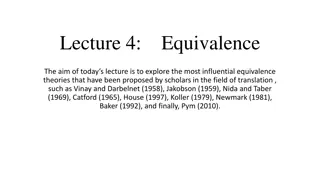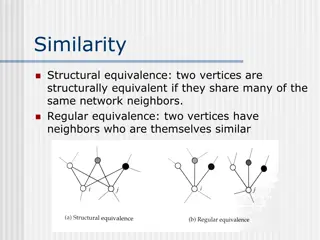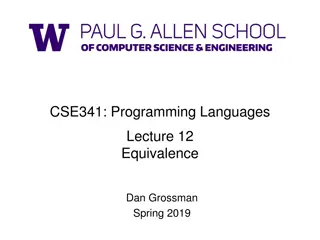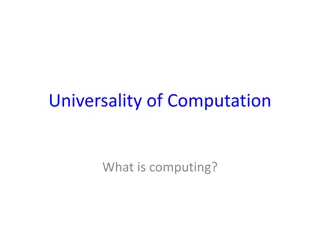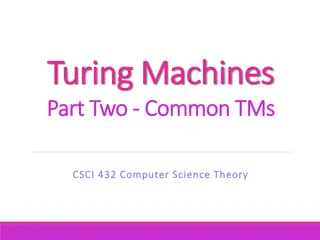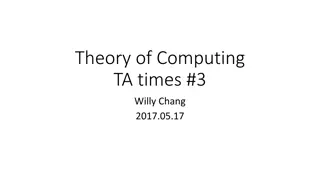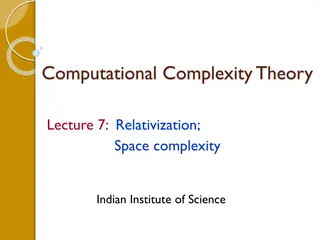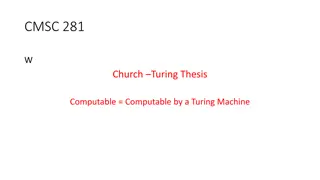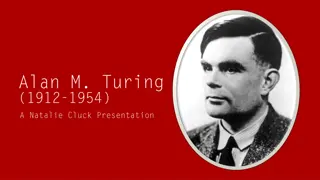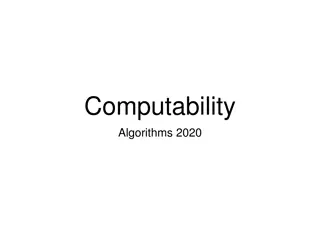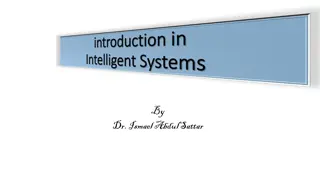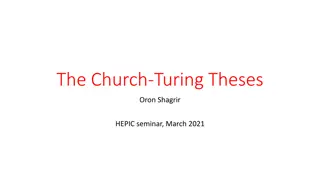Turing Equivalence & Universality in CS 121 Lecture
In this CS 121 lecture, topics such as Turing equivalence, universality, and Turing machine operations are discussed. The lecture covers essential concepts like the Turing-Church Thesis, Universal Turing Machine, and the structure of Turing Machines as defined by Barak. It delves into the capabilities of high-level programming languages compared to Turing Machines and prompts a discussion on their distinctive features. The lecture also emphasizes the importance of understanding the power and limitations of computational models.
Download Presentation

Please find below an Image/Link to download the presentation.
The content on the website is provided AS IS for your information and personal use only. It may not be sold, licensed, or shared on other websites without obtaining consent from the author.If you encounter any issues during the download, it is possible that the publisher has removed the file from their server.
You are allowed to download the files provided on this website for personal or commercial use, subject to the condition that they are used lawfully. All files are the property of their respective owners.
The content on the website is provided AS IS for your information and personal use only. It may not be sold, licensed, or shared on other websites without obtaining consent from the author.
E N D
Presentation Transcript
CS 121: Lecture 13 Turing Equivalence & Universality Madhu Sudan https://madhu.seas.Harvard.edu/courses/Fall2020 Book: https://introtcs.org { The whole staff (faster response): CS 121 Piazza How to contact us Only the course heads (slower): cs121.fall2020.course.heads@gmail.com
Announcements: Advanced Sections: Josh Alman on Matrix Multiplication Midterms yet to be graded. Will post details on Piazza when ready Homework 4 out today. Due in two weeks. Participation Survey done? Sign up for active participation here! Midterm Feedback Survey coming soon! Mandatory (5 points on homework 4.). Anonymous! Staff takes it seriously! (Be open call out specific people, actions). Section 6 cycle starts today. Material in usual place!
Where we are: Part I: Circuits: Finite computation, quantitative study Part II: Automata: Infinite restricted computation, quantitative study Part III: Turing Machines: Infinite computation, qualitative study Part IV: Efficient Computation: Infinite computation, quantitative study Part V: Randomized computation: Extending studies to non-classical algorithms
Today: Two results to be aware of, and to use (heavily)? No proofs to know/remember. Proofs/sketches available in book. We will discuss. But suffices to know they exist! Result 1: Turing-Church Thesis Provable part: TMs as powerful as any high-level programming language. Usable part: To prove computability, suffices to give program in high-level lang. Result 2: a Universal Turing Machine Takes as input description ? ? 0,1 of any Turing Machine, and ? 0,1 Outputs ? ? , the result computed by ? on ? (if ? halts) no output otherwise.
Recall Turing Machines (Barak, Definition 7.1): TM on ? states and alphabet 0,1, ,? is given by ?: ? ? Action, where Action = ?,?,?,? ?=Left, ?=Right, ?=Stay (don t move), ?=Halt (done!!) Operation: Start in state 0, Tape ? = General step: current state ? ; input symbol ?: Let ? ?,? = ?,?,? Write ? on tape (overwriting ?) ; Move to state ?; Move Head left (? ? 1) if ? = ?; right if ? = ?; don t move if ? = ?. Repeat General step until ? = ? ?0 ?? 1??? , Head (?) at ?0
Exercise Break 1 Pick a high-level language Identify features that are very different from Turing Machines. Discuss differences after the break.
My list of differences: General programming languages allow multiple, multidimensional arrays! TMs have one array : Tape[0, ] Allow ``random (arbitrary) access into arrays/memory. Can look at ?[?] in one step and then ? ?2+ 10? + 5 or even ? ? ? in next step TMs: If this step involves Tape[?] then next can only involve Tape ? 1 ,Tape ? ,Tape[? + 1] Rest? Syntactic Sugar Sophisticated constructs: loops, cases, recursion Data structures: Lists, Queues, Stacks
Dealing with the differences - 1 Random access: Deal with by brute force. Store index on Tape. Compute new index and overwrite on tape. Make a linear pass of tape to recover ?[?] (Quadratic slowdown in run time immediately)
Dealing with the differences - 2 Multiple Arrays+Indices Same solution. Multi-dimensional Arrays (Draw this out) Consequence: If algorithm A runs in time T with high-level program, can be implemented to run in time ? ?2 on Turing Machine. Details in Barak: Chapter 8
Road Map of details TMs Define NAND-TMs. Show equivalent to TMs. Just a program version of TMs. Like NAND circuits vs. NAND-CIRC programs. Define NAND-RAMs. Show equivalent to NAND-TMs. Allows loops and general indices. This is the crucial step. Define RAM machines. Show equivalent to NAND-RAMs This what most compilers use to compile down from the high-level spec. Equivalence straightforward.
HOCAEIT Theorem Have Our Cake And Eat It Too Recall definition of Computable. ?: 0,1 0,1 is computable iff it is computable by TM. Equivalence (HOCAEIT) Theorem: TMs are equivalent to High-Level Languages. Having our cake: To prove ? is computable only need to exhibit algorithm in high-level language. Eating it: To prove ? is not computable only need to rule out TMs.
Church-Turing Thesis Every function that is computable by physical means is (Turing Machine) computable. Some (made-up?) history: Church defined computability with ?-calculus Turing + Church compared notes and agreed their models were equivalent. Many other models were shown to be equivalent. Turing went on to do a postdoc under von Neumann. Von Neumann later introduced the stored program architecture of computer to the computer architects of the time. Led to the first physical computers. Conway invented Game of Life simplest Turing Equivalent model?
Universality One machine to rule them all There exists a single program/algorithm/TM that can run all other programs/algorithms/TMs. Formally: 1. There exists a way to encode Turing Machines so that they can be (part of) input to other Turing Machines. 2. The exists a universal machine ? that takes as input a pair (?,?) and outputs ? ?,? = ?(?) (if ? halts on ?)
Part 1: Encoding Turing Machines Should be familiar to us: Recall ? specified by >,0,1,? , ?, ?: ? ? {?,?,?,?} First encode ? : 0,1? ; ??: ?,?,?,? 0,12, ??: ? 0,1log ? so ?: 0,1log ?+ ? 0,1log ?+ ?+2 Encoding of ? = Enc ?,?,? 0,000 ,? 0,001 ? ? 1,111 0,1log ?+?+2 ?2? Encoding of ? = Enc(?,?,?) Where Enc: 0,1 is some 1-1 function.
Part 2: Interpreting the Encoding Definition: Configuration of a machine ? on input ? after ? steps of computation, denoted ??, is the full state of the computation : Current state of Turing Machine Current contents of the Tape Current location ? of Tape head Core of Universal TM ? Universal-Stepper : ?,?? ?,??+1
Exercise Break 2 Definition: Configuration of a machine ? on input ? after ? steps of computation, denoted ??, is the full state of the computation : Current state of Turing Machine Current contents of the Tape Current location ? of Tape head Discuss how to organize the information (?,??) on ? s tape: Describe (in English) steps needed to compute ?,?? ?,??+1
Computing ?,?? ?,??+1 Initially: Make space for (current state, head location, current symbol) In each round: fetch contents of Tape[head location] and update Look at the code of the TM to determine next state, next location, symbol to write. Write the symbol to write at current location. Update head location Conclusion: Lots of string manipulation (string copy), adjust nothing profound.
Summary of Lecture: Turing Equivalence and Turing-Church Thesis: No proofs to remember. But encouraged to read the text (Chapter 8) Do remember the HOCAEIT theorem! Do not leave home without it. To prove computability, give algorithm in high-level language. To prove non-computability, rule out TMs. Universal Turing machines: Single machine to simulate all others: Similar to circuits. Big difference: Simulates larger machines over larger alphabets!!!!
Next Lecture Uncomputability. Some functions are not computable no matter how much time we are willing to take!
